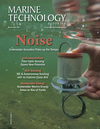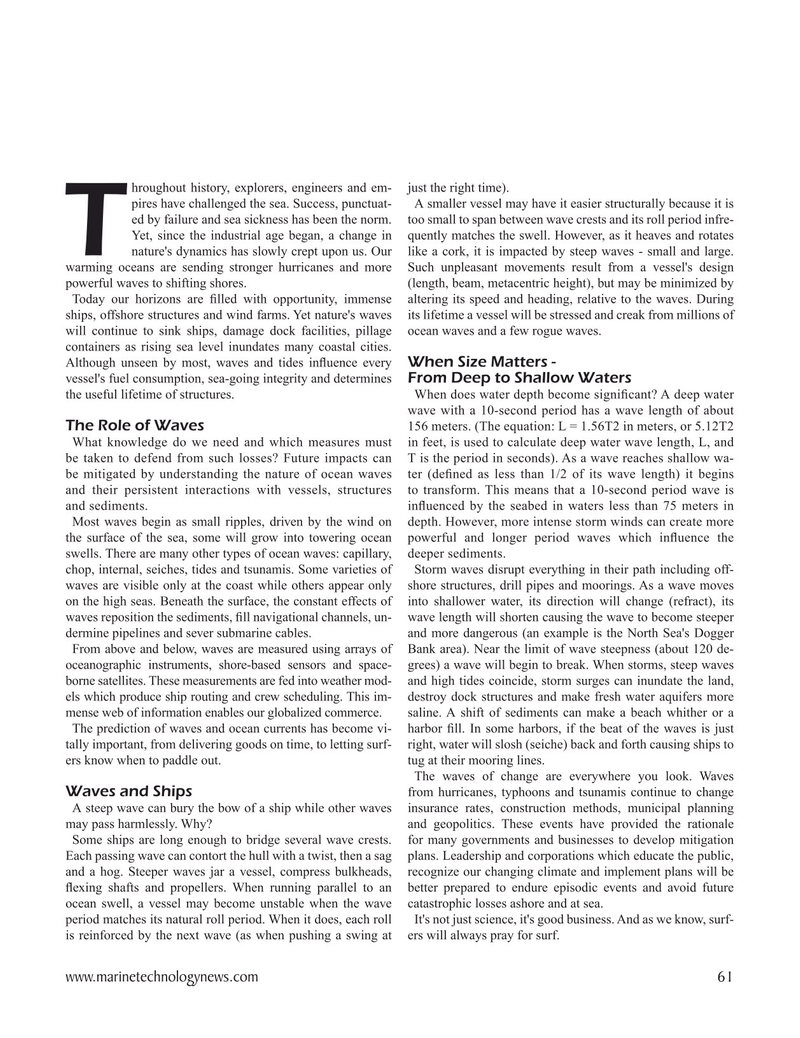
Page 61: of Marine Technology Magazine (March 2021)
Oceanographic Instrumentation & Sensors
Read this page in Pdf, Flash or Html5 edition of March 2021 Marine Technology Magazine
hroughout history, explorers, engineers and em- just the right time). pires have challenged the sea. Success, punctuat- A smaller vessel may have it easier structurally because it is ed by failure and sea sickness has been the norm. too small to span between wave crests and its roll period infre-
Yet, since the industrial age began, a change in quently matches the swell. However, as it heaves and rotates
T nature's dynamics has slowly crept upon us. Our like a cork, it is impacted by steep waves - small and large. warming oceans are sending stronger hurricanes and more Such unpleasant movements result from a vessel's design powerful waves to shifting shores. (length, beam, metacentric height), but may be minimized by
Today our horizons are ? lled with opportunity, immense altering its speed and heading, relative to the waves. During ships, offshore structures and wind farms. Yet nature's waves its lifetime a vessel will be stressed and creak from millions of will continue to sink ships, damage dock facilities, pillage ocean waves and a few rogue waves.
containers as rising sea level inundates many coastal cities.
Although unseen by most, waves and tides in? uence every
When Size Matters - vessel's fuel consumption, sea-going integrity and determines From Deep to Shallow Waters the useful lifetime of structures. When does water depth become signi? cant? A deep water wave with a 10-second period has a wave length of about 156 meters. (The equation: L = 1.56T2 in meters, or 5.12T2
The Role of Waves
What knowledge do we need and which measures must in feet, is used to calculate deep water wave length, L, and be taken to defend from such losses? Future impacts can T is the period in seconds). As a wave reaches shallow wa- be mitigated by understanding the nature of ocean waves ter (de? ned as less than 1/2 of its wave length) it begins and their persistent interactions with vessels, structures to transform. This means that a 10-second period wave is and sediments. in? uenced by the seabed in waters less than 75 meters in
Most waves begin as small ripples, driven by the wind on depth. However, more intense storm winds can create more the surface of the sea, some will grow into towering ocean powerful and longer period waves which in? uence the swells. There are many other types of ocean waves: capillary, deeper sediments.
chop, internal, seiches, tides and tsunamis. Some varieties of Storm waves disrupt everything in their path including off- waves are visible only at the coast while others appear only shore structures, drill pipes and moorings. As a wave moves on the high seas. Beneath the surface, the constant effects of into shallower water, its direction will change (refract), its waves reposition the sediments, ? ll navigational channels, un- wave length will shorten causing the wave to become steeper dermine pipelines and sever submarine cables. and more dangerous (an example is the North Sea's Dogger
From above and below, waves are measured using arrays of Bank area). Near the limit of wave steepness (about 120 de- oceanographic instruments, shore-based sensors and space- grees) a wave will begin to break. When storms, steep waves borne satellites. These measurements are fed into weather mod- and high tides coincide, storm surges can inundate the land, els which produce ship routing and crew scheduling. This im- destroy dock structures and make fresh water aquifers more mense web of information enables our globalized commerce. saline. A shift of sediments can make a beach whither or a
The prediction of waves and ocean currents has become vi- harbor ? ll. In some harbors, if the beat of the waves is just tally important, from delivering goods on time, to letting surf- right, water will slosh (seiche) back and forth causing ships to ers know when to paddle out. tug at their mooring lines.
The waves of change are everywhere you look. Waves from hurricanes, typhoons and tsunamis continue to change
Waves and Ships
A steep wave can bury the bow of a ship while other waves insurance rates, construction methods, municipal planning may pass harmlessly. Why? and geopolitics. These events have provided the rationale
Some ships are long enough to bridge several wave crests. for many governments and businesses to develop mitigation
Each passing wave can contort the hull with a twist, then a sag plans. Leadership and corporations which educate the public, and a hog. Steeper waves jar a vessel, compress bulkheads, recognize our changing climate and implement plans will be ? exing shafts and propellers. When running parallel to an better prepared to endure episodic events and avoid future ocean swell, a vessel may become unstable when the wave catastrophic losses ashore and at sea.
period matches its natural roll period. When it does, each roll It's not just science, it's good business. And as we know, surf- is reinforced by the next wave (as when pushing a swing at ers will always pray for surf.
www.marinetechnologynews.com 61
MTR #3 (50-63).indd 61 3/23/2021 9:44:21 AM

 60
60

 62
62
